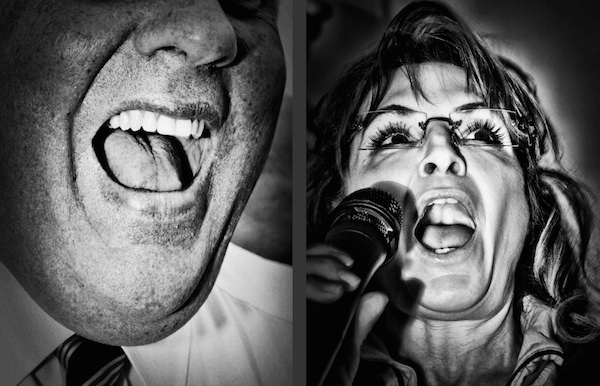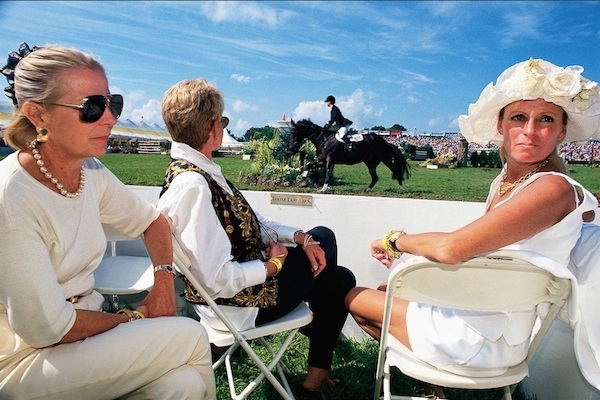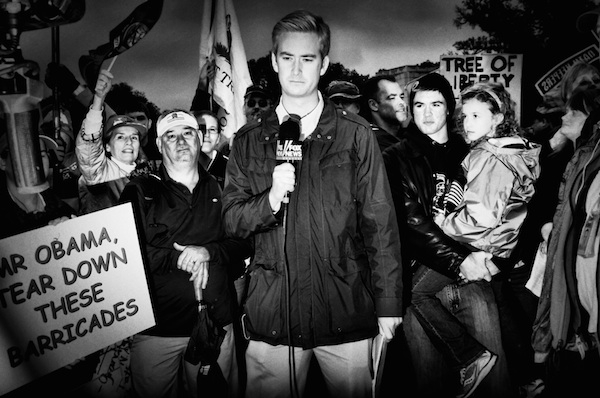Photographer Profile - Mark Peterson: "The flash is like crack to politicians"

|
|
|
The longtime Redux-agency photographer spent the winter and spring covering the nascent 2016 presidential election sweepstakes, traveling to political events in early battleground states as candidates (declared and undeclared) tuned up their messages and fundraising machines. With the Democrats seemingly locked in on Hillary Clinton, most of his time so far has been spent with Republicans. In February, he covered the Conservative Political Action Conference near Washington for Time magazine and MSNBC, where the stars of the GOP—from Sarah Palin and Donald Trump to former Texas Governor Rick Perry and Wisconsin Governor Scott Walker—gathered to burnish their bone fides as vote getters and right-wing icons.
Since part of a candidate’s viability depends on the personality he or she projects into the media’s many cameras, it seemed reasonable to ask for Peterson’s impressions about photogenic qualities of a few of the Republican presidential hopefuls.
For instance, Texas Senator Ted Cruz:
“Well, he can make every face in the book in one sentence,” says Peterson.
Kentucky Senator Rand Paul, says Peterson, “is not into the retail part of politics, so the disdain he shows at meet-and-greets is interesting to capture.”
On the other hand, Jeb Bush is highly polished. “He gives everyone in the room the perfect 15 seconds of attention,” Peterson says.
As a photographer, Peterson isn’t interested in what happens during those perfect 15 seconds of politics. He’s waiting to see what happens after they’re over.For the past two years, he has been working on a project he calls “Political Theater,” a series that looks beyond the camera-ready smiles of candidates and the stage-managed events in which they display their grasp of issues and their homespun charisma. His distinctive images—high-contrast black-and-white close-ups, scenes shot from oblique angles, tight framing—capture the moments when reality intrudes on the choreographed acts, providing an alternative to the narrative spun out on the nightly news.
“I’m trying to show the artificiality of the events,” he says. “They’re not these organic moments in which people just appear and talk about issues. They are set up for cameras—TV and stills. A lot of journalists are looking to present everybody in a perfect light. Maybe I’m trying to show the stage lights shining on them.”
Now that the curtain is lifting on the 2016 political show, Peterson is taking a front-row seat.
“I’m hoping to have some fun,” he says.
Politics As Theater
The project began after Peterson was assigned to cover a demonstration against Obamacare in front of the Capitol Building in Washington, D.C., in 2013. “When I went through my pictures later, they just didn’t look like the event I’d seen in person,” he says. “They didn’t show how orchestrated the whole thing had been, with senators walking down the Capitol steps at selected intervals to address the crowd. I wanted to communicate that reality to viewers.”
As he has come to understand, the first rule of political photography is to understand the absolute need politicians have for being in front of cameras.
“The flash is like crack to them,” says Peterson. “They really don’t care if a picture is flattering or not. Any publicity is good publicity.”
Peterson’s political portraits are certainly not always flattering. Often, they’re harshly lit and rendered—realism turned into expressionism. Chris Christie has been a frequent subject for Peterson, who invariable focuses on the New Jersey governor’s aggressive posture and unfurled tongue.

“I specifically tried to photograph different parts of him because he’s such a Shakespearean character,” Peterson says. “The photos are about how he approaches every question—it’s like someone’s got a dagger and they’re coming after him. So, for instance, I’ve made pictures that showed just his mouth.”
His technique for creating the pictures is surprisingly simple, and mobile: “I shoot everything with my DSLR, and I use flash, because I like how that freezes things and gives things a dimension,” he says. “But when the images come out of my DSLR, they don’t show the absurdity I want to communicate, so from there I put them into my cell phone and run them through these 99-cent apps that I bought.”
Reality Behind the News
Though “Political Theater” started as a personal series, it was soon discovered by magazine photo editors looking for a way to add depth to their election coverage. Assignments from Time, New York magazine, MSNBC, and the New York Times Magazine have in turn allowed Peterson to continue working on the project.
"Mark Peterson is a photographer who knows
how to distill the essence of any situation by focusing on the the subject and the drama around them with great acuity, especially on political coverage," says Paul Moakley, Time's Deputy Director of
Photography and Visual Enterprise. "No matter what side his eye scrutinizes, it's always with a great sense of gravitas, humor, and wit."
Throughout his career, Peterson
has been able to combine personal interests with editorial work in order to pursue long-term projects. Before his series on politics, he spent a decade working on a personal project looking at the
world of New York City’s high-society fundraising galas. Collected in the 2004 book Acts of Charity, Peterson’s images capture the culture of glittering philanthropy,
where social consciousness and social climbing go hand in hand.
The project started when the New York Times Magazine assigned Peterson to photograph Brooke Astor, who reined over New York society and gave away her millions to important causes. One day, Peterson accompanied Astor to an elementary school in Harlem that had benefited from her largesse.

“She was wearing $20,000 worth of clothing, not counting her jewelry, and full-length gloves up to her elbows,” Peterson says. “She was a really good person, and did good things with her money, but for the kids at this school, she was like a Martian. The contrast was incredible.”
For Peterson, who had only recently moved to New York from Minneapolis, that contrast, and the extravagance of the East Coast charity functions, were intriguing.
“In Minneapolis, that kind of display of wealth wasn’t part of society,” he says. “For me, it was like going to a different country and seeing a strange tribe and saying, ‘What is this?’”
The Opposite of Cynical
Essentially, that is what he has been asking since he became a photographer.
Peterson didn’t pick up a camera until he was 25, when he had a chance encounter with a photographer who worked in the Minneapolis office of the old UPI wire service. He taught himself photography by studying the work of others, including Robert Frank, Diane Arbus, Jeff Jacobson, Tom Arndt and Paul Shambroom. He spent some time working at City Pages, the Minneapolis alternative newspaper, where, he says, he learned how to shoot picture stories. He got a full-time job working at UPI, then decided it was time to move to New York, assuming he could lead a comfortable freelance life by shooting a magazine story once a month. Those plans were revised, he says, when he went through all his savings in three months.
The thread that ties his work together is the curiosity—you might also call it a healthy Midwestern naiveté—that he has managed to hang onto over the years, a desire to see first hand how the things really work in the big world.

“I never paid attention in junior high or high school, and I never went to college. So photography gave me the chance to learn the stuff I should have learned in school,” Peterson says. “I’m not talking about photography. I’m talking about the world and history.”
While his pictures often take arch views of people and events, they are the opposite of cynical. “I’m honestly trying to understand what things like politics are about,” he says. “And I’m trying to help other people understand.”


